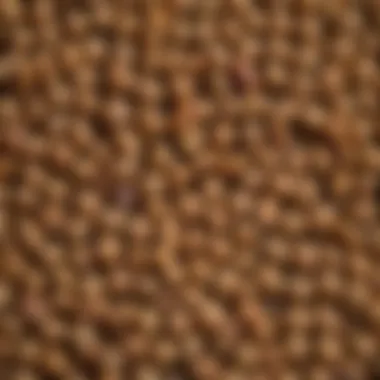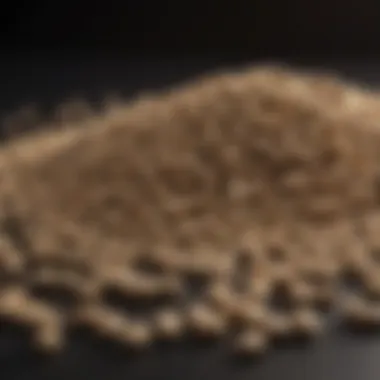Understanding Pet Food Pellets: A Complete Guide


Intro
Pet nutrition has become increasingly complex, with pet food options expanding rapidly. Among these, pet food pellets have emerged as a significant contender. Understanding their composition, benefits, and production methods is crucial for any responsible pet owner. This guide aims to clarify the various aspects of pet food pellets and how they affect your pet's health and well-being.
Understanding Your Pet
A successful pet care routine begins with a solid understanding of your pet's unique needs. Each pet behaves differently, influenced by breed characteristics and other factors.
Pet Behavior Basics
Understanding the behaviors of your pet can enhance your communication with them. Most pets display instinctual behaviors that are typical for their species. For example, dogs may show dominance, submission, or playfulness. On the other hand, cats may exhibit independence or curiosity. Owners should observe these behaviors closely.
Common Breed Characteristics
Different breeds have distinct traits. For instance, Labrador Retrievers are often friendly and energetic, while Bulldogs are more relaxed and calm. Knowing specific breed characteristics can guide you in selecting suitable pet food pellets that meet their nutritional needs.
Species-Specific Needs
Beyond breed, species plays a vital role in nutritional requirements. Dogs and cats require different levels of protein, fat, and carbohydrates. It is essential to tailor your pet’s diet based on these species-specific needs. Use pet food pellets designed for their specific nutritional requirements.
Pet Care and Maintenance
Maintaining a pet's health involves various routine practices that cover feeding, grooming, and hygiene.
Feeding Guidelines
Feeding guidelines vary across different types of pet food pellets. It is important to follow the recommendations provided on the packaging. Ensure your pet’s diet is high-quality, and adjust portion sizes based on their age, weight, and activity level.
Grooming Essentials
Regular grooming is essential for pet health. Brushing your pet not only keeps their coat clean but also helps you notice any skin issues. Determine how often to groom based on your pet's coat length and type.
Hygiene Practices
Establishing good hygiene practices is vital. Regularly clean your pet’s living area, toys, and food bowls. This helps prevent illness and contributes to their overall well-being.
Training and Development
Training plays a significant role in a pet’s mental and physical development. It affects their relationship with their owner and their behavior overall.
Basic Commands and Skills
Teach basic commands like
Preamble to Pet Food Pellets
Pet food pellets play a vital role in the nutrition of pets around the world. Understanding their composition and significance can substantially enhance pet care for owners. This article provides a comprehensive look at key elements surrounding pet food pellets.
The importance of pet food pellets can not be understated. They offer a convenient method to supply pets with essential nutrients. Properly formulated pellets ensure that animals consume a balanced diet. This diet is essential for maintaining good health and vitality.
In the vast market of pet food, the variety of options available can be overwhelming. Knowing the base materials and nutritional additives in these pellets is crucial. Pet owners must make informed decisions regarding their pet's food. Selection should take into account specific dietary nedds. Factors include age, breed, activity level, and any preexisting health conditions.
Another element to consider is the health benefits associated with different types of pellets. Studies have shown that certain formulations contribute positively to digestive health and weight management. Different pellet types, whether dry or moist, can play distinct roles in a pet's well-being. Moreover, understanding how to choose the right type is essential for optimizing health benefits.
Below is a summary of the main considerations regarding pet food pellets:
- Nutritional Composition: Understanding ingredients that make up the pellets.
- Health Impacts: How these foods affect your pet’s health long-term.
- Variety: Different types available, such as dry and grain-free options.
- Selection Criteria: Insight into choosing the right pellets for specific pets.
"Pet food pellets are not merely a convenience; they are a vital part of an animal's nutritional platform. A well-informed choice can lead to enhanced health and prolonged life."
As we dive deeper into this topic, it becomes clear that comprehending the world of pet food pellets is essential for pet owners. By fostering an understanding of what goes into these products, the benefits they confer, and how to select the right ones, owners can significantly influence their pets' overall health and longevity.


Definition and Composition
Understanding the definition and composition of pet food pellets is crucial for pet owners to ensure the health and well-being of their companions. This section provides insights into what pet food pellets are made of and their nutritional value. Recognizing the key components helps in selecting appropriate food for various pets, contributing to their overall health and longevity.
Primary Ingredients
The primary ingredients in pet food pellets generally include high-quality proteins, carbohydrates, fats, vitamins, and minerals. Proteins, such as chicken, beef, or fish, serve as the main source of energy and are essential for muscle maintenance. Carbohydrates, often derived from grains or legumes, provide energy and aid digestion. Fats contribute to healthy skin and coat, supporting absorption of fat-soluble vitamins. The balance of these ingredients influences both nutrition and palatability, making it vital for pet owners to scrutinize labels.
Nutritional Additives
Nutritional additives play a significant role in enhancing the dietary profile of pet food pellets. These can include probiotics for digestive health, omega fats for skin and coat improvement, and antioxidants for immune system support. Supplementation helps to address specific health concerns or deficiencies in pets. It is important to evaluate how these additives are integrated into the product to ensure they are beneficial and aligned with your pet’s health needs.
Common Variants
Pet food pellets come in several variants, each catering to different dietary requirements and preferences. Three common types are dry pellets, moist pellets, and grain-free options. Each variant has its unique characteristics and advantages, which align with specific pet needs.
Dry Pellets
Dry pellets are a well-known option, valued for their convenience and shelf stability. They often contain a higher concentration of nutrients due to the processing methods used. A key characteristic of dry pellets is their rigidity, which can promote dental health by reducing plaque buildup as pets chew. However, the moisture content is low, which may not be suitable for pets that primarily require hydration from their food.
Moist Pellets
Moist pellets offer a higher moisture content, making them an appealing choice for pets who need more hydration. This type of pellet can be beneficial for pets with dental issues, as the softer texture is easier to consume. The primary disadvantage is that moist pellets generally require refrigeration after opening and have a shorter shelf life compared to dry pellets.
Grain-Free Options
Grain-free options have gained popularity among pet owners, especially those concerned with allergies or sensitivities to grains. These pellets typically utilize alternative carbohydrates like sweet potatoes or peas. A defining characteristic is the focus on high protein content, which can support active pets. Nonetheless, some pets may experience digestive challenges with certain ingredients, making it essential for owners to monitor their pets’ reactions when switching to grain-free diets.
Production Processes
Understanding the production processes of pet food pellets is crucial in grasping how these diets impact overall pet health and nutrition. The process ensures the nutrients are preserved and that the final product is safe and palatable for animals. Additionally, knowing these processes can help pet owners in making informed choices about the products they buy for their pets. This section outlines the primary manufacturing methods and highlights quality control measures that prevail in the industry.
Manufacturing Methods
Extrusion
Extrusion is a widely-used method in the pet food industry. This process involves forcing ingredients through a machine at high temperature and pressure. A significant aspect of extrusion is how it creates a uniform texture and shape for the pellets. This is a beneficial choice as it ensures a consistent bite size, which many pets prefer.
One key characteristic of extrusion is its ability to cook the ingredients quickly. The high temperatures during the process kill harmful bacteria, making the product safer for consumption. On the downside, the intense heat may also degrade some sensitive nutrients. Thus, while extrusion is effective, brands must balance nutrient retention with safety measures. This unique feature of extrusion contributes significantly to the reliability of pet food quality in the market.
Pelletization
Pelletization is another important method for creating pet food pellets. In this process, the ingredients are compressed into small, round shapes. A particular aspect of pelletization is its focus on the physical form of the food. Many pet owners find that pets are more likely to eat and enjoy the pellets when they have a specific shape and size.
The primary characteristic of pelletization is its role in enhancing nutrient absorption. By producing small, manageable sizes, pets can digest the food better, allowing them to receive the necessary nutrients more efficiently. However, one drawback is that poorly executed pelletization can lead to density variations in the product, affecting both texture and palatability. Consequently, it is essential for manufacturers to pay attention to the intricacies of this method to ensure optimal product development.
Quality Control Measures
Quality control is a cornerstone of pet food production. This involves various tests and inspections to ensure that every batch of pellets meets nutritional and safety standards. Manufacturers monitor for contaminants and verify the nutritional content. Consistent quality checks not only prevent health risks but also ensure that the pet food aligns with its advertised benefits. By instilling rigorous quality control measures, pet food companies maintain their reputation and consumer trust across the industry.
In summary, understanding the production processes involved in creating pet food pellets provides insight into their quality and nutritional value.
Health Benefits of Pet Food Pellets
Pet food pellets are not just a convenient feeding option; they offer several health benefits. Understanding these advantages is essential for pet owners who want to ensure their pets thrive. This section covers important aspects such as digestive health, dental care, and weight management, highlighting why pellets can play a key role in a dog or cat's diet.
Digestive Health
A proper diet is fundamental for maintaining a pet's digestive health. Pet food pellets often include a balance of essential nutrients and fibers that promote healthy digestion. Fiber, for instance, is critical for regulating the digestive tract, helping to prevent issues such as constipation or diarrhea.
Moreover, pellets are typically formulated to contain prebiotics and probiotics. Prebiotics support the growth of beneficial bacteria in the gut, while probiotics introduce live microorganisms that enhance gut health. This combination is effective in promoting regular digestion and improving nutrient absorption, contributing to overall well-being.


Overall, selecting high-quality pellets can lead to a healthier digestive system for pets, reducing vet visits and digestive problems in the long run.
Dental Care
Maintaining good dental hygiene is vital for pets. Dental issues can lead to pain and more severe health problems. Pet food pellets can assist in supporting dental health through their texture. Chewing on harder pellets naturally helps reduce plaque and tartar buildup.
Many brands specifically design their pellets to have a crunchy texture. This design encourages pets to chew, leading to mechanical cleaning of the teeth. This dental benefit can help keep gums healthy and even freshen breath, contributing to better overall oral hygiene.
Regular consumption of appropriate pellets can be an easy way to enhance dental care along with routine veterinarian check-ups.
Weight Management
Obesity is a common issue among pets and can lead to various health complications. One way pet food pellets can aid in maintaining a healthy weight is through portion control. Unlike some other food formats, pellets enable pet owners to measure exact serving sizes easily, helping to prevent overfeeding.
Additionally, many pet food pellets are designed with balanced calories and nutrients that help maintain an ideal weight. High-quality pellets provide necessary energy while keeping your pet satiated, which can reduce the desire for excessive snacking throughout the day.
For pets, especially those less active, using pellets designed for weight management can significantly improve their quality of life by reducing the risks associated with obesity, like diabetes and joint issues.
Selecting the Right Pellets for Your Pet
Choosing the appropriate pet food pellets is crucial. It affects your pet's health, mood, and overall well-being. The right nutritional balance tailored to your pet’s needs can prevent health issues in the long run. There are several considerations to factor in, which helps ensure your pet thrives on a suitable diet.
Breed-Specific Needs
Each breed has unique nutritional requirements based on size, coat, and activity level. For instance, large breeds need different protein and calcium levels than smaller breeds. Feeding your pet the right pellet that aligns with their breed can prevent developmental issues and health problems.
- Chihuahuas may benefit from smaller pellet sizes because of their small jaws.
- Golden Retrievers require higher protein levels to maintain their energy.
Understanding these subtleties leads to better choices that can enhance your pet's life.
Life Stage Considerations
Age plays a vital role in selecting pet food pellets.
Puppies and Kittens
The growth phase for puppies and kittens is critical. They need a diet rich in proteins, fats, and essential vitamins. This foundation supports their rapid development. Furthermore, puppies and kittens have specific dietary needs that help build their bones and muscles. Choosing high-quality pellets can ensure they get necessary nutrients for healthy development. For example, specialized formulas are tailored for their fast metabolism, providing the necessary energy.
However, some owners might fall into the trap of feeding these young pets regular adult formulas which can lead to deficiencies.
Adult Pets
Adult pets require balanced nutrition to maintain their health. Their metabolism stabilizes compared to their younger selves, which means their energy needs decrease. Selecting pellets designed for adults can help in managing their weight and sustaining their health effectively. These pellets often contain an adequate mix of proteins, fats, and fiber. It is crucial to monitor their activity level to adjust their food intake accordingly. An active dog will need higher energy content compared to a less active one.
Inappropriate feeding can lead to obesity, which results in multiple health problems.
Senior Pets
Senior pets need special attention due to changing health conditions. Older pets may have decreased metabolism and may require lower calorie diets. In addition, senior pets often face dental issues, so selecting softer pellets can ease their feeding process. Nutritional formulas designed for older pets often include joint support nutrients, which help alleviate arthritic pain.
Feeding a proper balanced diet can prolong their life and maintain their quality of life. Clearly, paying attention to age-specific needs is fundamental for their continued health.
"Choosing the right food for your pet is not just about filling a bowl but ensuring a longer, healthier companionship."
As pet ownership continues to evolve, understanding these aspects of your pet’s diet is crucial for optimal health. Taking the time to research and select appropriate pellets based on breed and lifecycle ensures your pet can lead a safe and healthy life.
Common Misconceptions about Pet Food Pellets
When discussing pet food pellets, many misconceptions arise. These misunderstandings can negatively impact the choices pet owners make for their beloved companions. Examining these misconceptions is critical because it helps clarify the reality surrounding pet nutrition options. Incorrect assumptions can lead to poorly informed decisions that affect pet health and wellbeing.
Understanding Ingredients


One of the largest misunderstandings regarding pet food pellets is the confusion over ingredients. Many believe that all pet food is created equal, leading to unfounded fears about specific items in the ingredient lists. Commonly, owners might mistake
Sustainability in Pet Food Production
Sustainability in pet food production has gained substantial attention in recent years. This focus is essential, as it addresses the growing concerns regarding environmental impact, resource conservation, and ethical sourcing. Pet owners today are increasingly aware of how their choices affect the planet. They want to ensure their pets’ diets align with their values regarding sustainability.
Sustainability refers to practices that do not deplete resources or harm ecological systems. In the context of pet food, this includes various aspects like ingredient sourcing, production methods, and packaging. The significance is twofold. Firstly, it helps to reduce the carbon footprint associated with pet food manufacturing and distribution. Secondly, it encourages ethical considerations surrounding animal welfare and ingredient sourcing.
Eco-Friendly Ingredients
When it comes to eco-friendly ingredients, the emphasis is on using sustainable sources that do not strain the environment. This includes:
- Plant-Based Proteins: Ingredients such as lentils, chickpeas, and peas are excellent protein sources. They require less land and water compared to traditional animal proteins.
- Locally Sourced Ingredients: Sourcing ingredients close to production facilities reduces transportation emissions. It contributes to local economies as well.
- Sustainable Seafood: For pets that enjoy fish, it is crucial to select sources that promote overfishing or habitat destruction. Organizations like the Marine Stewardship Council certify seafood products that follow sustainable practices.
- Ethically Raised Animal Proteins: These involve sourcing meat from farms that practice humane treatment of animals and require certification for adherence to ethical standards.
Pet food brands are beginning to prioritize these eco-friendly ingredients. This shift offers a more sustainable future for both pets and the planet.
Packaging Innovations
Another significant aspect of sustainability is the packaging used for pet food products. Many traditional packaging materials, such as plastic, harm the environment significantly. Thus, innovations in packaging are crucial. Some prominent trends include:
- Biodegradable Materials: Packaging made from renewable resources that biodegrade is a key development.
- Recyclable Components: Brands are moving towards designing packages that consumers can easily recycle, contributing to reducing landfill waste.
- Reduced Packaging Size: By minimizing packaging, manufacturers can cut down on materials used and transportation costs, which, in turn, lowers emissions.
- Refillable Options: Some companies offer refillable pouches or containers, discouraging single-use plastics and promoting sustainable practices among pet owners.
Sustainable packaging reduces the environmental footprint of pet food and promotes consumers' active participation in eco-friendly practices.
In summary, sustainability in pet food production is critical for fostering a healthier planet. From eco-friendly ingredients to innovative packaging solutions, these practices signify a commitment to environmental stewardship. As pet owners become more conscious of their choices, the demand for sustainable options will likely continue to grow.
Future Trends in Pet Food Pellets
The concept of future trends in pet food pellets reflects an evolving landscape in pet nutrition. As pet ownership increases globally, understanding these trends becomes critical for pet owners, industry professionals, and researchers alike. The significance of this section lies in its ability to shed light on how dietary needs of pets will continue to change and adapt in response to both consumer demand and scientific advancements. More importantly, the recognition of these trends can empower pet owners to make choices that best suit their animal's health and preferences.
Customized Nutrition
Customized nutrition is emerging as a pivotal trend within the realm of pet food pellets. This approach involves tailoring pet food formulations to meet the unique needs of individual pets. Factors such as breed, age, weight, and health conditions are increasingly influencing the type of nutrition pets receive. For instance, a growing number of companies are producing specialized formulas for pets with specific dietary restrictions or health issues such as allergies.
- Personalized options enhance health outcomes.
- Analysis of the pet's specific nutritional requirements fosters better dietary management.
- Convenience of pre-packaged tailored pellets ensures ease of feeding.
Moreover, advances in technology allow for better tracking of a pet's health metrics. This can lead to more informed decisions on the nutritional approaches best suited for pets. Embracing customized nutrition not only improves pet health but also solidifies the relationship between owners and their pets through thoughtful consideration of their dietary needs.
Technological Advancements
Technological advancements play a crucial role in shaping the future of pet food pellets. These innovations span from production processes to smart feeding solutions that enhance the overall feeding experience. One notable advancement is in the area of ingredient sourcing. Companies are increasingly investing in technology to trace sources of ingredients back to their origin, ensuring quality and sustainability.
Key aspects of these technological developments include:
- Smart Feeding Solutions: Devices that monitor pet eating habits and adjust portions according to the pet's requirements.
- Enhanced Production Methods: Improved extrusion and pelletization techniques that preserve nutritional value while increasing digestibility.
The integration of technology not only aids in ensuring the quality of the end product but also provides pet owners with tools to understand how their pets interact with food. Technology, therefore, is set to redefine not just how pet food is produced, but also how it is consumed.
As we look to the future, the alignment of customized nutrition and technological advancements suggests a move towards a more tailored, efficient, and responsible approach in pet food. Keeping pace with these trends is essential for any pet owner aiming to optimize their pet's health and well-being.
End
In this article, we explored the complex landscape of pet food pellets, highlighting their essential role in pet nutrition. Understanding the composition, types, and production processes of these pellets is crucial for pet owners. As we concluded, the choice of pellets can greatly influence a pet's health and well-being.
Pet food pellets are not just a convenient option. They are scientifically formulated to meet the dietary needs of various pets. The ingredients play a significant role, and as pet owners, recognizing quality and nutritional value is key to making informed decisions.
Key Considerations in Choosing Pet Food Pellets:
- Nutritional Needs: Different pets require various nutrients based on age, breed, and health conditions.
- Ingredient Quality: Being aware of the primary ingredients and nutritional additives helps in identifying the right pellet.
- Production Standards: Knowing the manufacturing processes can inform about the quality control measures in place.
- Sustainability: The consideration for ecological factors in production practices is becoming increasingly important for conscientious pet owners.
"Understanding pet food pellets allows owners to provide their pets with well-rounded nutrition that addresses health concerns and lifestyle needs."
In summary, the systematic approach to selecting pet food pellets ensures that the dietary choices support the overall health and happiness of pets. The insights from this guide position pet owners to make educated choices that enhance the lives of their furry companions. As such, we advocate for continuing education on pet nutrition trends and remaining aware of both emerging technologies and traditional practices in pet food production.
Importance of References in This Article
The references used in this article serve multiple essential purposes:
- Credibility: Relying on established sources helps validate the claims made throughout the guide. Readers are more likely to trust information that is supported by reputable studies or expert opinions.
- Contextual Understanding: References provide background and context. For example, knowing how certain ingredients affect pet health can often be traced back to specific studies or analyses.
- Encouraging Further Exploration: Pet owners interested in understanding pet food pellets deeply will benefit from the links pointing to additional articles, research papers, or industry reports. These resources empower them to explore topics that may not be fully covered within the scope of this article.
- Addressing Common Misconceptions: By referencing authoritative studies, we can clarify and debunk misconceptions about pet food pellets. This gives readers a more rounded view of the subject.
- Supporting Future Trends: With changing landscapes in both pet food production and consumer preferences, references help to project the future of pet food pellets. They can highlight emerging research that foreshadows new product innovations or dietary recommendations.







